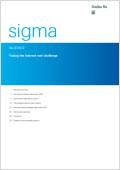 Interest rates affect all insurers, but the impact differs by line of business and also by product. Add this to the fact that interest rates can be highly volatile, and that it would be foolish to believe that interest rates can be predicted mid- to long-term with any reasonable precision. Therefore, insurers need to be prepared for all possible interest rate scenarios. Swiss Re’s sigma 4/2012, "Facing the interest rate challenge", explores the impact of interest rates on insurers and explains why a rapid rise in or sustained low interest rates can be a challenge for the road ahead. Interest rates affect all insurers, but the impact differs by line of business and also by product. Add this to the fact that interest rates can be highly volatile, and that it would be foolish to believe that interest rates can be predicted mid- to long-term with any reasonable precision. Therefore, insurers need to be prepared for all possible interest rate scenarios. Swiss Re’s sigma 4/2012, "Facing the interest rate challenge", explores the impact of interest rates on insurers and explains why a rapid rise in or sustained low interest rates can be a challenge for the road ahead.
"Short-tail business profitability in non-life is only marginally affected by interest rates, and long-tail non-life business interest rate risk can be contained with proper asset-liability management. Yet when interest rates are low, the only way for non-life insurers to maintain profitability is to raise premium rates," explains sigma co-author Astrid Frey.
Within life insurance, interest rate sensitivity varies by product, with savings business being the most affected. Life insurers therefore need to go beyond re-pricing their guarantees and focus on adjusting their product offerings to mitigate their exposure to interest rate risk. "It is time for the life insurance industry to reassess the life savings business. Insurers should review what policyholders are really willing to pay for the various guarantees embedded in the contracts and compare that to the economic costs of the guarantees. Guarantees that are expensive to hedge, but create little value for policyholders should eventually be eliminated," proposes co-author Lukas Steinmann. Surprisingly, lower guarantees can improve both insurers' risk/return profiles and the trade-off between costs and benefits for policyholders.
Looking ahead, insurers will need to shift their focus away from the current low-yield environment and be able to cope with the entire spectrum of interest rate scenarios. The challenge will be to adjust insurance products in a way that, in the end, both insurers and policyholders are better off.

|

